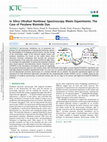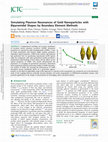Papers by Marco Garavelli

Chemical Reviews, 2019
Multichromophoric biosystems represent a broad family with very diverse members, ranging from lig... more Multichromophoric biosystems represent a broad family with very diverse members, ranging from light-harvesting pigment−protein complexes to nucleic acids. The former are designed to capture, harvest, efficiently transport, and transform energy from sunlight for photosynthesis, while the latter should dissipate the absorbed radiation as quickly as possible to prevent photodamages and corruption of the carried genetic information. Because of the unique electronic and structural characteristics, the modeling of their photoinduced activity is a real challenge. Numerous approaches have been devised building on the theoretical development achieved for single chromophores and on model Hamiltonians that capture the essential features of the system. Still, a question remains: is a general strategy for the accurate modeling of multichromophoric systems possible? By using a quantum chemical point of view, here we review the advancements developed so far highlighting differences and similarities with the single chromophore treatment. Finally, we outline the important limitations and challenges that still need to be tackled to reach a complete and accurate picture of their photoinduced properties and dynamics.

Spectroscopy simulations are of paramount importance for the interpretation of experimental elect... more Spectroscopy simulations are of paramount importance for the interpretation of experimental electronic spectra, the disentangling of overlapping spectral features, and the tracing of the microscopic origin of the observed signals. Linear and nonlinear simulations are based on the results drawn from electronic structure calculations that provide the necessary parameterization of the molecular systems probed by light. Here, we investigate the applicability of excited-state properties obtained from linear-response time-dependent density functional theory (TDDFT) in the description of nonlinear spectra by employing the pseudowavefunction approach and compare them with benchmarks from highly accurate RASSCF/RASPT2 calculations and with high temporal resolution experimental results. As a test case, we consider the prediction of femtosecond transient absorption and two-dimensional electronic spectroscopy of a perylene bisimide dye in solution. We find that experimental signals are well reproduced by both theoretical approaches, showing that the computationally cheaper TDDFT can be a suitable option for the simulation of nonlinear spectroscopy of molecular systems that are too large to be treated with higher-level RASSCF/RASPT2 methods.
Journal of Computational Chemistry

This work demonstrates how push−pull substitution can induce spectral tuning toward the visible r... more This work demonstrates how push−pull substitution can induce spectral tuning toward the visible range and improve the photoisomerization efficiency of azobenzene-based photoswitches, making them good candidates for technological and biological applications. The red-shifted bright ππ* state (S 2) behaves like the lower and more productive dark nπ* (S 1) state because less potential energy along the planar bending mode is available to reach higher energy unproductive nπ*/S 0 crossing regions, which are responsible for the lower quantum yield of the parent compound. The stabilization of the bright ππ* state and the consequent increase in isomerization efficiency may be regulated via the strength of push−pull substituents. Finally, the torsional mechanism is recognized here as the unique productive route because structures with bending values attributable to the inversion mechanism were never detected, out of the 280 ππ* time-dependent density functional theory (RASPT2-validated) dynamics simulations.

Computational modeling and accurate simulations of localized surface plasmon resonance (LSPR) abs... more Computational modeling and accurate simulations of localized surface plasmon resonance (LSPR) absorption properties are reported for gold nanobipyramids (GNBs), a class of metal nanoparticle that features highly tunable, geometrydependent optical properties. GNB bicone models with spherical tips performed best in reproducing experimental LSPR spectra while the comparison with other geometrical models provided a fundamental understanding of base shapes and tip effects on the optical properties of GNBs. Our results demonstrated the importance of averaging all geometrical parameters determined from transmission electron microscopy images to build representative models of GNBs. By assessing the performances of LSPR absorption spectra simulations based on a quasi-static approximation, we provided an applicability range of this approach as a function of the nanoparticle size, paving the way to the theoretical study of the coupling between molecular electron densities and metal nanoparticles in GNB-based nanohybrid systems, with potential applications in the design of nanomaterials for bioimaging, optics and photocatalysis.
Physical Chemistry Chemical Physics
TD-DFT characterization of the high-energy singlet excited state manifold of the canonical DNA/RN... more TD-DFT characterization of the high-energy singlet excited state manifold of the canonical DNA/RNA nucleobases in vacuum is assessed against RASPT2 reference computations for reliable simulations of linear and non-linear electronic spectra.
Chemistry – A European Journal
Faraday Discussions
In the present contribution we introduce an accurate theoretical approach for the simulation of N... more In the present contribution we introduce an accurate theoretical approach for the simulation of NEXAFS spectra of organic molecules, employing azobenzene as a test case.
Chemistry – A European Journal
EPJ Web of Conferences
By combining transient absorption spectroscopy with sub-20-fs UV pulses and ab initio numerical s... more By combining transient absorption spectroscopy with sub-20-fs UV pulses and ab initio numerical simulations we follow the ultrafast dynamics in pyrimidine nucleosides and visualize the passage through conical intersections presiding excited state deactivation.
EPJ Web of Conferences
4-thiouracil (4TU) is studied by transient absorption spectroscopy employing sub-20 fs UV-pulses ... more 4-thiouracil (4TU) is studied by transient absorption spectroscopy employing sub-20 fs UV-pulses and hybrid QM(CASPT2) / MM(AMBER) computations (static and dynamic), evidencing that, along the photoexcited relaxation pathway, intersystem crossing originates from a dark intermediate state.

Theoretical Chemistry Accounts
A computational protocol based on the complete and restricted active space self-consistent field ... more A computational protocol based on the complete and restricted active space self-consistent field (CASSCF/RASSCF) methods and their second-order perturbation theory extensions (CASPT2/RASPT2) is employed to benchmark the highly excited state manifold of the DNA/RNA canonical purine nucleobase guanine in vacuo. Several RASPT2 schemes are tested, displaying a steady convergence of electronic transition energies and dipole moments upon active space enlargement towards the reference values. The outcome allows calibrating and optimizing computational efforts by considering cheaper and more approximate RAS schemes that could enable the characterization of the excited state manifolds of multichromophoric systems, such as DNA/RNA nulceobase dimers or multimers. Simulations of two-dimensional electronic spectra show similar trends to those observed on the other purine nucleobase adenine, deviating from this and other pyrimidine nucleobases in featuring its main excited state absorption signal, embodied by sizable double HOMO to LUMO excitation contributions, in the UV probing window.
Physical Chemistry Chemical Physics
The most relevant ‘dark’ electronic excited states in DNA/RNA pyrimidine nucleosides are mapped i... more The most relevant ‘dark’ electronic excited states in DNA/RNA pyrimidine nucleosides are mapped in water employing hybrid MS-CASPT2/MM optimisations with explicit solvation and including the sugar.
Journal of Molecular Modeling

Journal of the American Chemical Society
The study concerns the relaxation of electronic excited states of the DNA nucleoside Deoxycytidin... more The study concerns the relaxation of electronic excited states of the DNA nucleoside Deoxycytidine (dCyd) and its methylated analogue 5-methyl-deoxycytidine (5mdCyd), known to be involved in the formation of UV-induced lesions of the genetic code. Due to the existence of four closely lying and potentially coupled excited states, the deactivation pathways in these systems are particularly complex and have not been assessed so far. Here, we provide a complete mechanistic picture of the excited state relaxation of dCyd/5mdCyd in three solvents, water, acetonitrile, and tetrahydrofuran by combining femtosecond fluorescence experiments, addressing the effect of solvent proticity on the relaxation dynamics of dCyd and 5mdCyd for the first time, and two complementary Quantum Mechanical approaches (CASPT2/MM and PCM/TD-CAM-B3LYP). The lowest energy ππ* state is responsible for the sub-ps lifetime observed for dCyd in all the solvents. In addition, computed Excited State Absorption and Transient IR spectra allow, for the first time, to assign the tens-of-ps time constant, reported previously, to a dark state (n O π*) involving the carbonyl Lone Pair. A second low-lying dark state, involving the Nitrogen Lone Pair (n N π*), does significantly participate in the excited state dynamics. 267 nm excitation of dCyd leads to a non-negligible population of the second bright ππ* state, which affects the dynamics acting mainly as a 'doorway' state for the n O π* state. The solvent plays a key role governing the interplay between the different excited states; unexpectedly, water favors population of the dark states. In the case of 5mdCyd, an energy barrier present on the main non-radiative decay route explains the six-fold lengthening of excited state lifetime compared to dCyd, observed for all the examined solvents. Moreover, C5-methylation destabilizes both n O π* and n N π* dark states, thus preventing them to be populated.
Journal of the American Chemical Society

Chemistry - A European Journal
The T-T photodimerization paths leading to the formation of cyclobutane pyrimidine dimer (CPD) an... more The T-T photodimerization paths leading to the formation of cyclobutane pyrimidine dimer (CPD) and 6-4 pyrimidine pyrimidone (64-PP), the two main DNA photolesions, have been resolved for a T-T step in a DNA duplex by two complementary state-of-the-art quantum mechanical approaches: QM(CASPT2//CASSCF)/MM and TD-DFT/PCM. Based on the analysis of several different representative structures, we define a new-ensemble of cooperating geometrical and electronic factors (besides the distance between the reacting bonds) ruling T-T photodimerization in DNA. CPD is formed by a barrierless path on an exciton state delocalized over the two bases. Large interbase stacking and shift values, together with a small pseudorotation phase angle for T at the 3'-end, favor this reaction. The oxetane intermediate, leading to a 64-PP adduct, is formed on a singlet T→T charge-transfer state and is favored by a large interbase angle and slide values. A small energy barrier (<0.3 eV) is associated to this path, likely contributing to the smaller quantum yield observed for this process. Eventually, a clear directionality is always shown by the electronic excitation characterizing the singlet photoactive state driving the photodimerization process: an exciton that is more localized on T3 and a 5'-T→3'-T charge transfer for CPD and oxetane formation, respectively, thus calling for specific electronic constraints.
The Journal of Physical Chemistry Letters






Uploads
Papers by Marco Garavelli